The World’s Most Stunning Sea Caves
Sea caves, natural formations created by wind and water slowly eroding shore cliffs, are found all around the world. Many are geographical anomalies, featuring a unique convergence of natural elements. Most are extremely difficult to access, requiring precise timing, tidal comprehension, and seafaring prowess. These are, of course, often the most magnificent.
Here are 10 of the most stunning sea caves in the world, from Chile to Spain to California.
Neptune’s Grotto, Alghero, Italy
 photo by Tobias Helfrich / Wikimedia
photo by Tobias Helfrich / Wikimedia
The entrance to this stalactite cave is about a meter above sea level at the foot of the Capo Caccia cliffs, so it’s only accessible when the waters are calm. Only the first few hundred meters of the cave are open to the public, and the only way to enter it by land is to descend the 600+ escala del cabirol, or “goat steps,” carved into the cliff wall. Neptune’s Grotto is surrounded by many larger and even less accessible marine caves, including the Nereo Cave, a very popular scuba-diving destination.
Fingal’s Cave, Staffa, Scottland
 photo by Graeme Pow / Flickr
photo by Graeme Pow / Flickr
Novelist Sir Walter Scott described Fingal’s Cave as “One of the most extraordinary places I ever beheld.” Known to the Celts as Uamh-Binn or “The Cave of Melody,” one Irish legend explained the existence of both this cave and the Giant’s Causeway in Ireland. As both are made of the same neat basalt columns, the legend holds that they were the end pieces of a bridge built by the Irish giant Fionn mac Cumhaill to Scotland where he was to fight Benandonner, his gigantic Scottish rival. The legend is, in effect, geologically correct; both the Giant’s Causeway and Fingal’s Cave were created by the same ancient lava flow, which may have at one time formed a “bridge” between the two sites. The columns were formed by an enormous mass of hot lava cooling so slowly that, like mud under the hot sun, it cracked into long hexagonal forms.
Grotta Azzurra, Anacapri, Italy
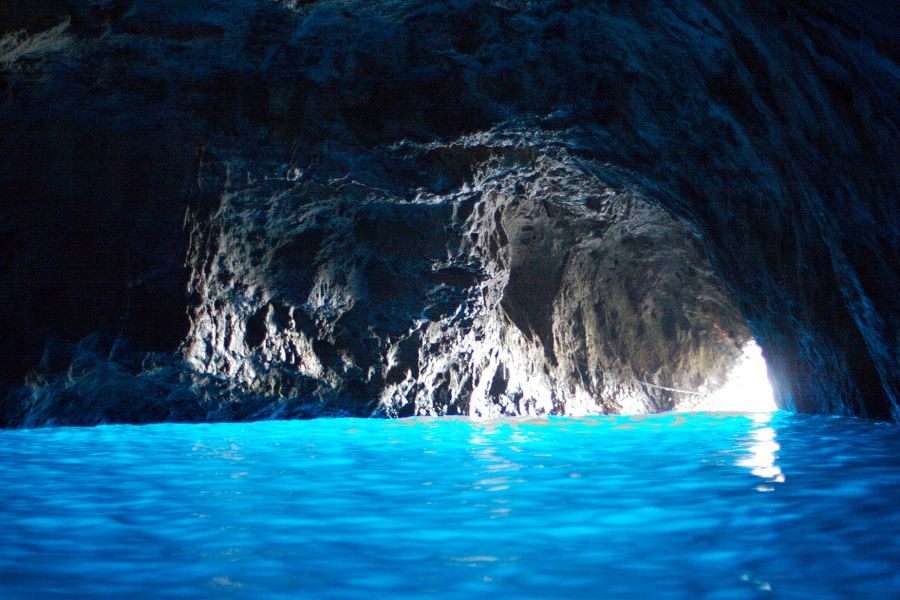 photo by Franco / Flickr
photo by Franco / Flickr
In Roman times, the Blue Grotto was the personal swimming hole of the Emperor Tiberius, and three Roman statues of sea gods were recovered from the ocean floor in the 1960s. The cave was long avoided by locals, because it was said to be inhabited by monsters or evil spirits, but nowadays it is a very popular tourist destination. No swimming is allowed, and visitors may only enter by boat, lying on the bottom to squeak through the 4 x 4 foot cave entrance. Inside, the waters glow an otherworldly blue against the darkness of the cave above.
Apostle Island Sea Caves, Wisconsin, USA
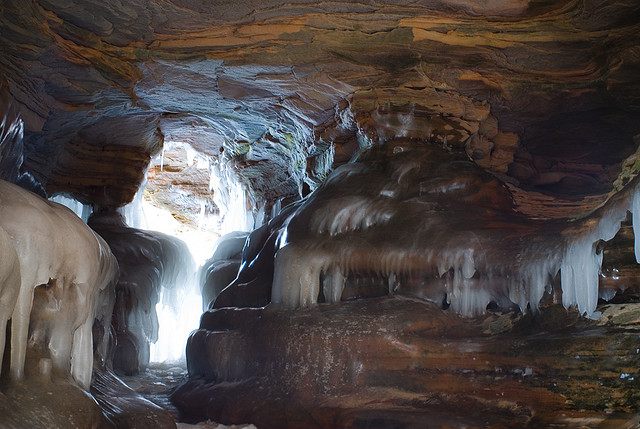 photo by ira_hendricks / Flickr
photo by ira_hendricks / Flickr
The Apostle Islands are home to some of the most stunning caves in the world — although they should technically not be called sea caves since they’re on Lake Superior. During summer red sandstone can be seen between sapphire lake and the emerald forests at the brink of the cliffs, but in winter these caves truly sparkle. When the lake freezes, the dampness on the cave walls and ceiling ices over, resulting in cave walls covered with millions of delicate icicles. The formations change from chamber to chamber and day to day.
Great Blue Hole, Belize City, Belize

photo by USGS / Wikimedia
Not all sea caves are entered by floating on the water — some have to be reached by diving. The Bahamas are riddled with subsurface caves, also called blue holes — oxygen-less caverns that are among the most inhospitable places in the world. But just across the Caribbean Sea is the largest and most famous underwater sinkhole: Belize’s 400-foot-deep Great Blue Hole. This “vertical cave” features stalactites up to 9 feet, several species of tropical fish, and crystal-clear water through which to view them all. Jacques Cousteau declared it one of the ten best diving places in the world.
Cuevas de Mármol, Chile Chico, Chile
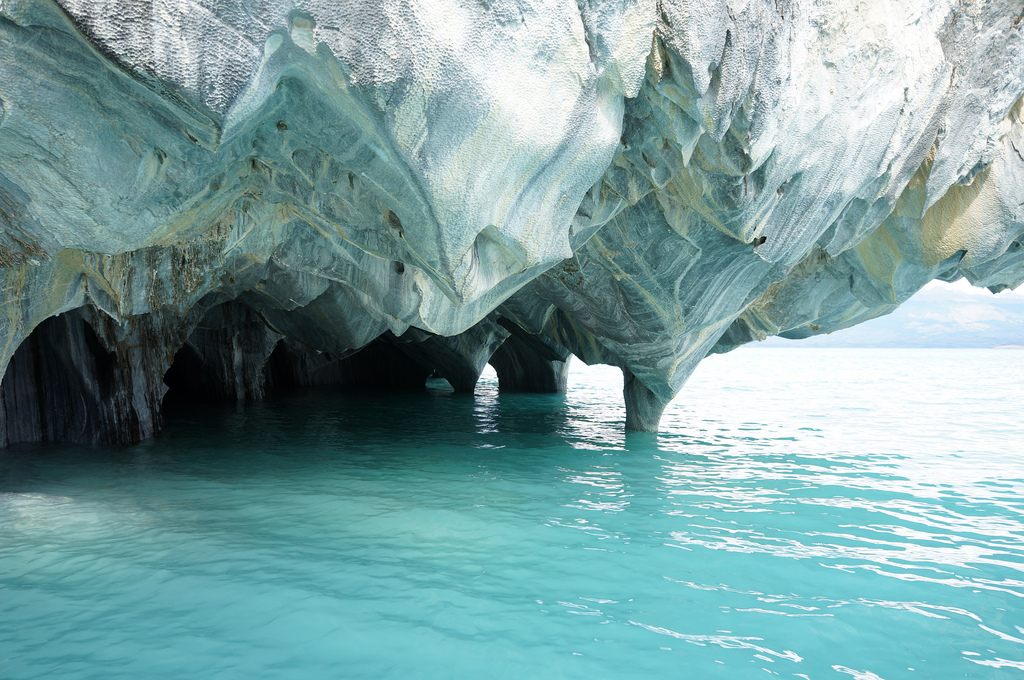 photo by phyxiusone / Flickr
photo by phyxiusone / Flickr
Formed by wave action over the last 6,200 years, Chile’s Marble Caves are part of a peninsula made of solid marble jutting into the glacial General Carrera Lake near the small town of Puerto Tranquilo. The block of marble from which the water has carved the striated caves has been estimated to weigh 5 billion tons. Near the Marble Caves are other natural marble formations, including Catedral de Mármol (Marble Cathedral) and Capilla de Mármol (Marble Chapel). The colors of both the lake and the caves changes throughout the year based on the weather.
Waiahuakua Cave, Kauai, Hawaii
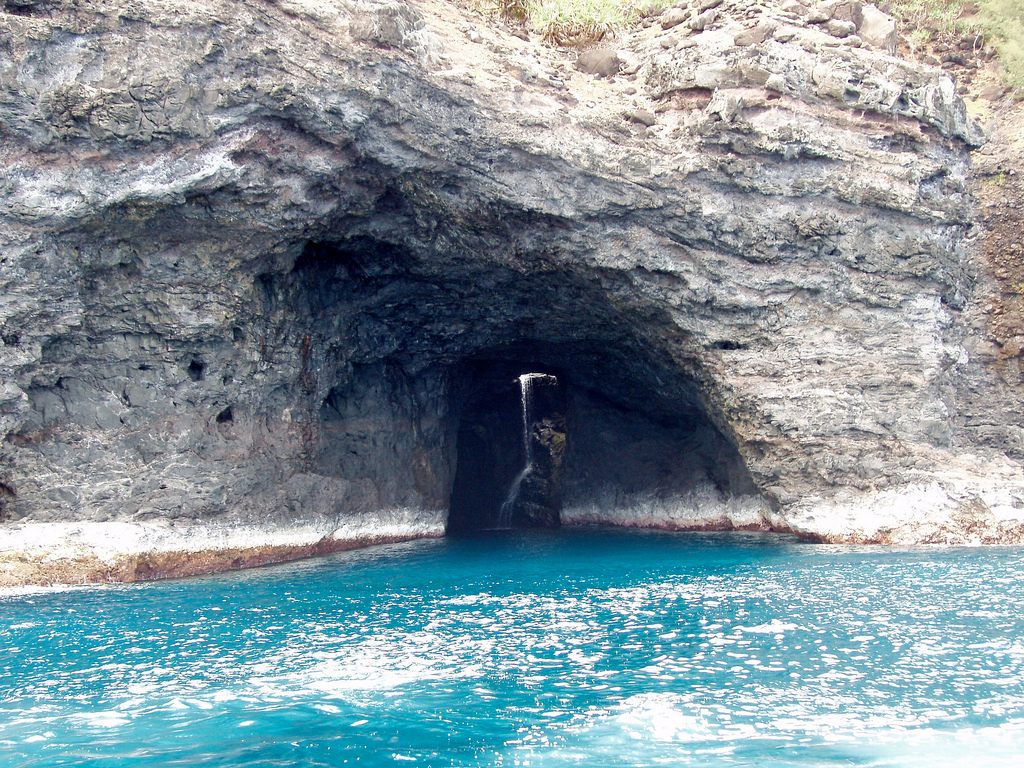 photo by 2kS4 / Flickr
photo by 2kS4 / Flickr
The second-longest sea cave in the world at 1,155 feet, Waiahuaka is also known as the Sacred Water Cave and the Double Door cave. It is along Kauai’s Na Pali, accessible only by water. The cave has several unusual features, including a big cathedral room, a white-lit tunnel hallway and a pinkish-red “death rock” in the shape of a hippo, but the most unusual is that a fissure in the ceiling lets in a waterfall course into the cave. At certain times of day during the summer, a beam of light shines through the same hole, illuminating the waterfall like a bolt of lightning.
Playa de las Catedrales, Ribadeo, Spain
 photo by Christophe / Flickr
photo by Christophe / Flickr
Nearly inaccessible during high tide, Spain’s Playa de las Catedrales (Cathedral Beach) becomes a wonderland of cliffs, arches, and sea caves when the tide goes out. Originally called Praia de Augas Santas (Beach of the Holy Waters), the beach was renamed because of these incredible natural formations, some soaring as high as 30 meters, like the ceiling of a cathedral.
Cathedral Cove Sea Cave, Coromandel, New Zealand
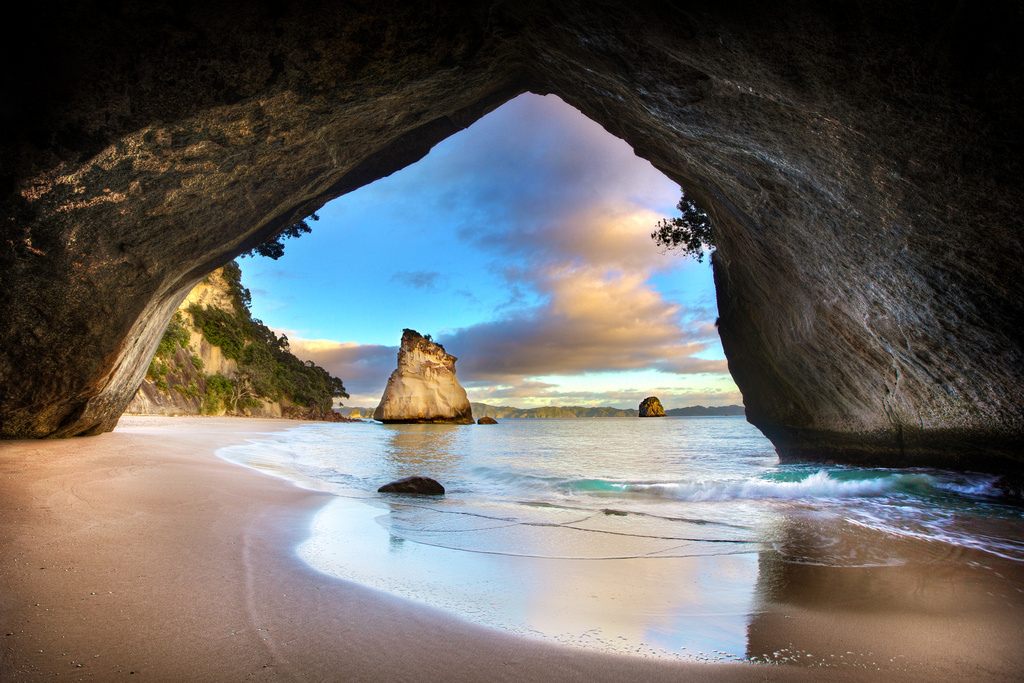 photo by Daniel Peckham / Tumblr
photo by Daniel Peckham / Tumblr
Another cave named after European cathedrals, Cathedral Cove holds five sea caves, one of which is among the longest in the world. Cathedral Cove is only accessible for two hours a day, when the tide is at its lowest. It’s one of the most popular tourist attractions on the Catlins Coast in southeastern New Zealand. The caves are completely dark, but intrepid (flashlight-wielding) visitors are likely to come across blue penguins and seals in their depths.
Painted Cave, California, USA

photo by Dave Bunnell / Wikimedia
Santa Cruz Island features 77 miles of craggy coastline, including the Painted Cave, one of the largest and deepest in the world. This cave gets its unique colors from the variety of rock types that make up its walls, as well as lichen and algae that adhere to them. The cave is 160 feet high and nearly a quarter mile long, with several inner chambers. An added wonder: in the spring, a waterfall sparkles over the entrance.

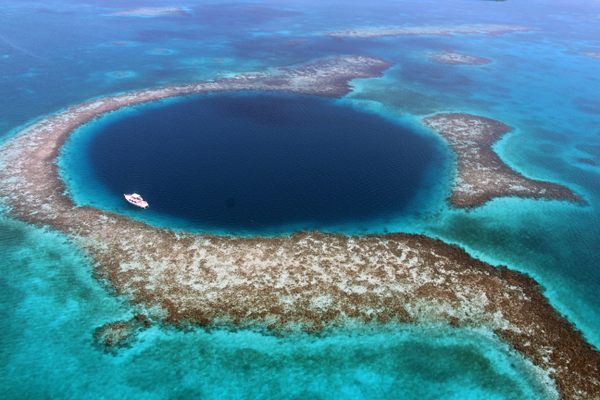















Follow us on Twitter to get the latest on the world's hidden wonders.
Like us on Facebook to get the latest on the world's hidden wonders.
Follow us on Twitter Like us on Facebook